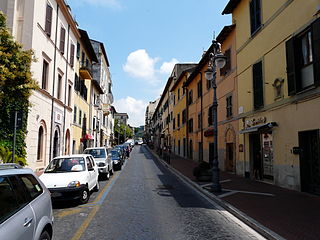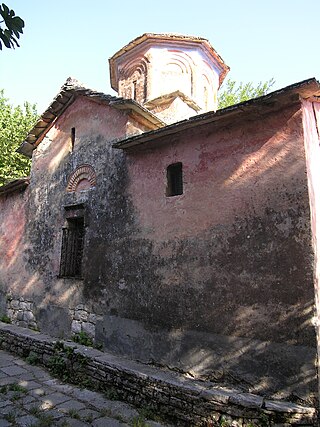
The Codex Sinaiticus, designated by siglum א [Aleph] or 01, δ 2, also called Sinai Bible, is a fourth-century Christian manuscript of a Greek Bible, containing the majority of the Greek Old Testament, including the deuterocanonical books, and the Greek New Testament, with both the Epistle of Barnabas and the Shepherd of Hermas included. It is written in uncial letters on parchment. It is one of the four great uncial codices. Along with Codex Alexandrinus and Codex Vaticanus, it is one of the earliest and most complete manuscripts of the Bible, and contains the oldest complete copy of the New Testament. It is a historical treasure, and using the study of comparative writing styles (palaeography), it has been dated to the mid-fourth century.

Saint Catherine's Monastery, officially the Sacred Autonomous Royal Monastery of Saint Catherine of the Holy and God-Trodden Mount Sinai, is a Christian monastery located in the Sinai Peninsula of Egypt. Located at the foot of Mount Sinai, it was built between 548 and 565, and is the world's oldest continuously inhabited Christian monastery.

The Holy Lavra of Saint Sabbas, known in Arabic and Syriac as Mar Saba and historically as the Great Laura of Saint Sabas, is a Greek Orthodox monastery overlooking the Kidron Valley in the Bethlehem Governorate of Palestine, in the West Bank, at a point halfway between Bethlehem and the Dead Sea. The monks of Mar Saba and those of subsidiary houses are known as Sabaites.

Saint Alexander Nevsky Lavra or Saint Alexander Nevsky Monastery was founded by Peter I of Russia in 1710 at the eastern end of the Nevsky Prospekt in Saint Petersburg, in the belief that this was the site of the Neva Battle in 1240 when Alexander Nevsky, a prince, defeated the Swedes. But the battle took place about 19 kilometres (12 mi) away from that site. "On April 5, 1713, in St. Petersburg, in the presence of Peter I, the wooden Church of the Annunciation was consecrated. This day is considered the official founding date of the Alexander Nevsky Lavra."

The Syriac Sinaiticus or Codex Sinaiticus Syriacus (syrs), known also as the Sinaitic Palimpsest, of Saint Catherine's Monastery, or Old Syriac Gospels is a late-4th- or early-5th-century manuscript of 179 folios, containing a nearly complete translation of the four canonical Gospels of the New Testament into Syriac, which have been overwritten by a vita (biography) of female saints and martyrs with a date corresponding to AD 697. This palimpsest is the oldest copy of the Gospels in Syriac, one of two surviving manuscripts that are conventionally dated to before the Peshitta, the standard Syriac translation.

Grottaferrata is a comune (municipality) in the Metropolitan City of Rome Capital, situated on the lower slopes of the Alban Hills, 20 kilometres southeast of Rome. It has grown up around the Abbey of Santa Maria di Grottaferrata, founded in 1004. Nearby communes include Frascati, Rocca di Papa, Marino and Rome.

May 28 - Eastern Orthodox Church calendar - May 30

Isḥaq of Nineveh, also remembered as Saint Isaac the Syrian, Isaac of Nineveh, Abba Isaac, Isaac Syrus and Isaac of Qatar, was a 7th-century Syriac Christian bishop of the Church of the East, and theologian best remembered for his written works on Christian asceticism. He is regarded as a saint in the Catholic, Eastern Orthodox, Oriental Orthodox Church and Church of the East traditions. His feast day falls, together with 4th-century theologian and hymnographer St. Ephrem the Syrian, on January 28.

The Saint George the Zograf Monastery or Zograf Monastery is one of the twenty Eastern Orthodox monasteries in Mount Athos in Greece. It was founded in the late 9th or early 10th century by three Bulgarians from Ohrid and is regarded as the historical Bulgarian monastery on Mount Athos, and is traditionally inhabited by Bulgarian Orthodox monks.
A sticheron is a hymn of a particular genre sung during the daily evening (Hesperinos/Vespers) and morning (Orthros) offices, and some other services, of the Eastern Orthodox and Byzantine Catholic churches.

The Abbey of Saint-Victor, Marseille is a former abbey that was founded during the late Roman period in Marseille in the south of France, named after the local soldier saint and martyr, Victor of Marseilles.

Dionysiou Monastery is an Eastern Orthodox monastery at the monastic state of Mount Athos in Greece, at the southwest part of the Athos peninsula. The monastery ranks fifth in the hierarchy of the Athonite monasteries. It is one of the twenty self-governing monasteries in Athos, and it was dedicated to John the Baptist.

The Coptic White Monastery, also The Monastery of Abba Shenouda and The Athribian Monastery is a Coptic Orthodox monastery named after Saint Shenoute. It is located near the Upper Egyptian cities of Tahta and Sohag, and about two and a half miles (4.0 km) south-east of the Red Monastery.

Codex Climaci Rescriptus is a collective palimpsest manuscript consisting of several individual manuscripts underneath, Christian Palestinian Aramaic texts of the Old and New Testament as well as two apocryphal texts, including the Dormition of the Mother of God, and is known as Uncial 0250 with a Greek uncial text of the New Testament and overwritten by Syriac treatises of Johannes Climacus : the scala paradisi and the liber ad pastorem. Paleographically the Greek text has been assigned to the 7th or 8th century, and the Aramaic text to the 6th century. It originates from Saint Catherine's Monastery going by the New Finds of 1975. Formerly it was classified for CCR 5 and CCR 6 as lectionary manuscript, with Gregory giving the number ℓ 1561 to it.

The Dhuvjan Monastery, also known as Monastery of Saints Quiricus and Julietta, is an Eastern Orthodox monastery located in the western part of the village of Dhuvjan, Gjirokastër County, southern Albania. Founded in 1089 when the area was part of the Byzantine Empire, today it is part of the Albanian Orthodox Church.
Kir Stefan the Serb was a Serbian monk, protopsaltos, musicologist, choirmaster and more importantly, composer of the chants developed within the sphere of the activities of Byzantine culture in the Serbian state. Together with Isaiah the Serb and Nikola the Serb he followed faithfully the Byzantine musical traditions, writing in the late kalophonic style of the 14th and 15th centuries. With his distinctive compositional style, he is one of the earliest identifiable Medieval Serbian composers and also one of the original founders of new and distinctive style called Serbo-Byzantine school.

Saint Euthymios of Zela the Ethno-Hieromartyr,, born Eustratios Agritellis, 1876–1921, was the last resident bishop of the Diocese of Zela, near Amasia, Western Pontus, which he served from June 12, 1912, until his death on May 29, 1921, during the period of the Greek genocide.
Codex Sabaiticus can refer to a number of ancient manuscripts, most of which are currently housed in the Patriarchal Library in Jerusalem, that were originally preserved by "Sabaite" monks from the monastery of Mar Saba in what is today the Bethlehem Governorate of Palestine, in the West Bank.


















